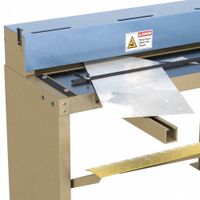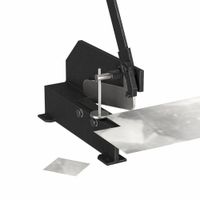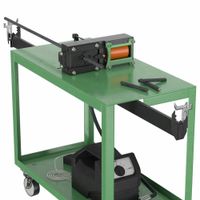Call +(254) 703 030 000 / 751 483 999 / 721 704 777
- Home
- Machining
- Machinery
- Metal Fabrication Machines
- Metal Shearing Machines
.....Read More
Frequently Asked Questions
What is a metal shearing machine used for?
A metal shearing machine is used for cutting sheet metal and plate material to size. It operates by applying a high force to a metal workpiece, causing it to shear or fracture along a predetermined line. This process is essential in various industries, including automotive, aerospace, construction, and manufacturing, where precise cuts are necessary for creating components and structures.
The machine typically consists of a fixed upper blade and a movable lower blade. The metal sheet is placed between these blades, and as the lower blade moves, it exerts pressure on the metal, causing it to shear. The shearing process can be performed on different types of metals, such as steel, aluminum, brass, and copper, and can handle various thicknesses depending on the machine's capacity.
Metal shearing machines come in different types, including guillotine shears, alligator shears, and bench shears, each designed for specific applications and material thicknesses. Guillotine shears are commonly used for straight cuts and can handle large sheets, while alligator shears are suitable for cutting long metal stock or scrap. Bench shears are smaller and used for lighter materials or more precise cuts.
The advantages of using a metal shearing machine include high efficiency, accuracy, and the ability to produce clean, straight cuts with minimal waste. It is a cost-effective method for cutting metal, as it requires less energy compared to other cutting techniques like laser or plasma cutting. Additionally, shearing machines can be automated for high-volume production, further enhancing productivity and consistency in manufacturing processes.
How does a metal shearing machine work?
A metal shearing machine operates by applying a high force to cut through metal sheets or plates. The process involves a fixed blade and a moving blade. The metal sheet is placed between these two blades. When the machine is activated, the moving blade descends or moves laterally, depending on the machine design, to shear the metal against the fixed blade.
The shearing action is similar to using a pair of scissors, where the two blades pass each other closely to create a clean cut. The machine can be powered manually, hydraulically, or electrically, with hydraulic and electric shears being more common in industrial settings due to their efficiency and power.
Key components of a metal shearing machine include:
1. **Blades**: Made from hardened steel to withstand the cutting force and maintain sharpness.
2. **Hold-downs**: These clamps secure the metal sheet in place to prevent movement during cutting.
3. **Back gauge**: This adjustable component determines the length of the cut by positioning the metal sheet accurately.
4. **Control system**: Modern machines often have computerized controls for precision and ease of operation.
The shearing process is efficient for cutting straight lines and is used in various industries for tasks like cutting metal sheets to size, trimming edges, or preparing blanks for further processing. The machine's capacity is determined by the thickness and type of metal it can cut, with different models designed for specific materials and thickness ranges.
What are the different types of metal shearing machines?
1. **Guillotine Shear**: Utilizes a straight blade to cut metal sheets. The upper blade moves vertically, while the lower blade remains stationary. Ideal for straight cuts.
2. **Alligator Shear**: Features a hinged jaw resembling an alligator's mouth. Used for cutting long metal stock or scrap into smaller pieces.
3. **Bench Shear**: A compact, manually operated shear for cutting small metal sheets or rods. Suitable for light-duty tasks.
4. **Power Shear**: Electrically or pneumatically powered, these shears are used for cutting thicker metal sheets with precision and speed.
5. **Throatless Shear**: Allows for cutting in any direction without being limited by the throat depth. Ideal for intricate shapes and curves.
6. **Hydraulic Shear**: Uses hydraulic power to exert force on the blades, enabling the cutting of thicker and tougher metals with ease.
7. **Rotary Shear**: Employs circular blades to cut metal sheets. Often used in continuous production lines for cutting coiled metal.
8. **Nibblers**: A type of shear that removes small bits of metal, allowing for intricate cuts and curves. Suitable for sheet metal work.
9. **Swing Beam Shear**: The upper blade swings in an arc to cut the metal, providing a smooth and precise cut. Common in industrial applications.
10. **Flying Shear**: Used in continuous production lines, it cuts moving metal sheets or bars without stopping the line, ensuring efficiency.
11. **CNC Shear**: Computer-controlled shears that offer high precision and automation, suitable for complex and repetitive cutting tasks.
12. **Beverly Shear**: A hand-operated shear designed for cutting sheet metal with precision, often used in metalworking shops for detailed work.
What materials can be cut with a metal shearing machine?
A metal shearing machine is designed to cut various types of materials, primarily metals, with precision and efficiency. The materials that can be cut using a metal shearing machine include:
1. **Steel**: This includes mild steel, carbon steel, and stainless steel. These are commonly used in construction, automotive, and manufacturing industries.
2. **Aluminum**: Due to its lightweight and corrosion-resistant properties, aluminum is frequently used in aerospace, transportation, and packaging industries.
3. **Brass**: Known for its acoustic properties and corrosion resistance, brass is often used in musical instruments, plumbing, and decorative applications.
4. **Copper**: With excellent electrical conductivity, copper is widely used in electrical wiring, plumbing, and industrial machinery.
5. **Titanium**: Valued for its strength-to-weight ratio and corrosion resistance, titanium is used in aerospace, medical devices, and high-performance applications.
6. **Alloys**: Various metal alloys, such as those combining nickel, chromium, or molybdenum, can be sheared for use in specialized applications requiring specific mechanical properties.
7. **Sheet Metal**: This includes thin, flat pieces of metal that are used in metalworking and can be made from any of the above materials.
8. **Galvanized Steel**: Steel coated with a layer of zinc to prevent rusting, commonly used in outdoor and industrial applications.
9. **Tin**: Often used in the production of cans and other packaging materials due to its corrosion resistance.
10. **Lead**: Used in applications requiring radiation shielding or soundproofing.
11. **Zinc**: Commonly used for galvanizing other metals to prevent rusting.
The capability of a metal shearing machine to cut these materials depends on factors such as the machine's design, blade material, and the thickness of the material being cut.
How do you maintain a metal shearing machine?
1. **Regular Cleaning**: Remove metal shavings, dust, and debris from the machine surfaces and components to prevent wear and tear.
2. **Lubrication**: Apply appropriate lubricants to moving parts such as blades, gears, and bearings to reduce friction and prevent rust.
3. **Blade Maintenance**: Regularly inspect blades for sharpness and damage. Sharpen or replace them as needed to ensure clean cuts and prevent machine strain.
4. **Alignment Checks**: Ensure that the blades and other critical components are properly aligned to maintain precision and prevent uneven wear.
5. **Hydraulic System Care**: For hydraulic shears, check fluid levels and replace hydraulic oil periodically. Inspect hoses and seals for leaks or damage.
6. **Electrical System Inspection**: Check electrical connections, wiring, and control panels for signs of wear or damage. Ensure all safety switches and emergency stops are functional.
7. **Fastener Tightening**: Regularly inspect and tighten bolts, nuts, and screws to prevent loosening due to machine vibrations.
8. **Safety Features**: Test safety guards, emergency stops, and other protective devices to ensure they are operational and compliant with safety standards.
9. **Calibration**: Periodically calibrate the machine to maintain accuracy in cuts and ensure consistent performance.
10. **Operator Training**: Ensure operators are trained in proper machine use and maintenance procedures to prevent misuse and extend machine life.
11. **Documentation**: Keep detailed records of maintenance activities, inspections, and repairs to track machine health and schedule future maintenance.
12. **Professional Servicing**: Schedule regular professional inspections and servicing to address complex issues and ensure optimal machine performance.
What safety precautions should be taken when using a metal shearing machine?
1. **Training and Certification**: Ensure operators are properly trained and certified to use the machine.
2. **Personal Protective Equipment (PPE)**: Wear appropriate PPE, including safety goggles, gloves, steel-toed boots, and hearing protection.
3. **Machine Inspection**: Regularly inspect the machine for any signs of wear, damage, or malfunction. Ensure all safety guards and devices are in place and functional.
4. **Work Area Safety**: Keep the work area clean and free of obstructions. Ensure adequate lighting and ventilation.
5. **Emergency Stops**: Familiarize yourself with the location and operation of emergency stop buttons and switches.
6. **Material Handling**: Use proper techniques and tools for handling and positioning materials to avoid injury.
7. **Clear Communication**: Maintain clear communication with coworkers, especially when multiple operators are involved.
8. **No Loose Clothing**: Avoid wearing loose clothing, jewelry, or anything that could get caught in the machine.
9. **Proper Setup**: Ensure the machine is set up correctly for the specific material and thickness being cut.
10. **Focus and Attention**: Stay focused and avoid distractions while operating the machine.
11. **Lockout/Tagout Procedures**: Follow lockout/tagout procedures during maintenance or when the machine is not in use.
12. **Regular Maintenance**: Conduct regular maintenance as per the manufacturer's guidelines to ensure optimal performance and safety.
13. **Load Limits**: Do not exceed the machine's specified load limits to prevent damage and accidents.
14. **Use of Guards**: Never bypass or disable safety guards and devices.
15. **Safe Distance**: Keep hands and other body parts at a safe distance from the cutting area.
16. **Emergency Procedures**: Be aware of emergency procedures and first aid measures in case of an accident.
What are the advantages of using a metal shearing machine?
1. **Precision and Accuracy**: Metal shearing machines provide high precision and accuracy in cutting, ensuring clean and straight edges without the need for secondary finishing processes.
2. **Efficiency and Speed**: These machines can cut through metal quickly, significantly increasing production speed and efficiency, which is ideal for high-volume manufacturing.
3. **Versatility**: Metal shearing machines can handle a variety of metals and thicknesses, making them suitable for diverse applications across different industries.
4. **Cost-Effectiveness**: By reducing the need for additional finishing and minimizing material waste, shearing machines help lower production costs.
5. **Minimal Material Waste**: The shearing process produces minimal kerf (material loss), optimizing material usage and reducing waste.
6. **Low Maintenance**: Metal shearing machines generally require less maintenance compared to other cutting methods, leading to lower operational costs.
7. **Safety**: Modern shearing machines are equipped with safety features that protect operators, reducing the risk of accidents and injuries.
8. **Energy Efficiency**: These machines often consume less energy compared to other cutting technologies, contributing to lower energy costs and a smaller carbon footprint.
9. **Ease of Operation**: With user-friendly controls and automation options, metal shearing machines are easy to operate, reducing the need for extensive training.
10. **Consistency**: They provide consistent results with each cut, ensuring uniformity in production and high-quality end products.
11. **Reduced Heat Affected Zone**: Unlike thermal cutting methods, shearing does not produce a heat-affected zone, preserving the metal's structural integrity.
12. **Adaptability**: Shearing machines can be integrated into automated production lines, enhancing overall workflow and productivity.


